Exploring Job Satisfaction: Measurement Techniques and Strategies
VerifiedAdded on 2021/04/24
|6
|1467
|101
Essay
AI Summary
This essay provides an analysis of job satisfaction, exploring its meaning, the difficulties in measuring it, and various methods that can be used for its assessment. It discusses Locke's definition of job satisfaction as a positive emotional state resulting from job appraisal and highlights the multidimensional nature of job satisfaction, including cognitive, affective, and behavioral components. The essay also examines models for measuring job satisfaction, such as the input-output model and the bi-dimensional model, and discusses tools like the Job Satisfaction Survey and Job Descriptive Index. Furthermore, it elucidates strategies for increasing job satisfaction within an organization, including addressing employee concerns, reducing micro-management, and improving small workplace factors. The conclusion emphasizes the subjective nature of job satisfaction and the importance of using appropriate tools and strategies to enhance it.
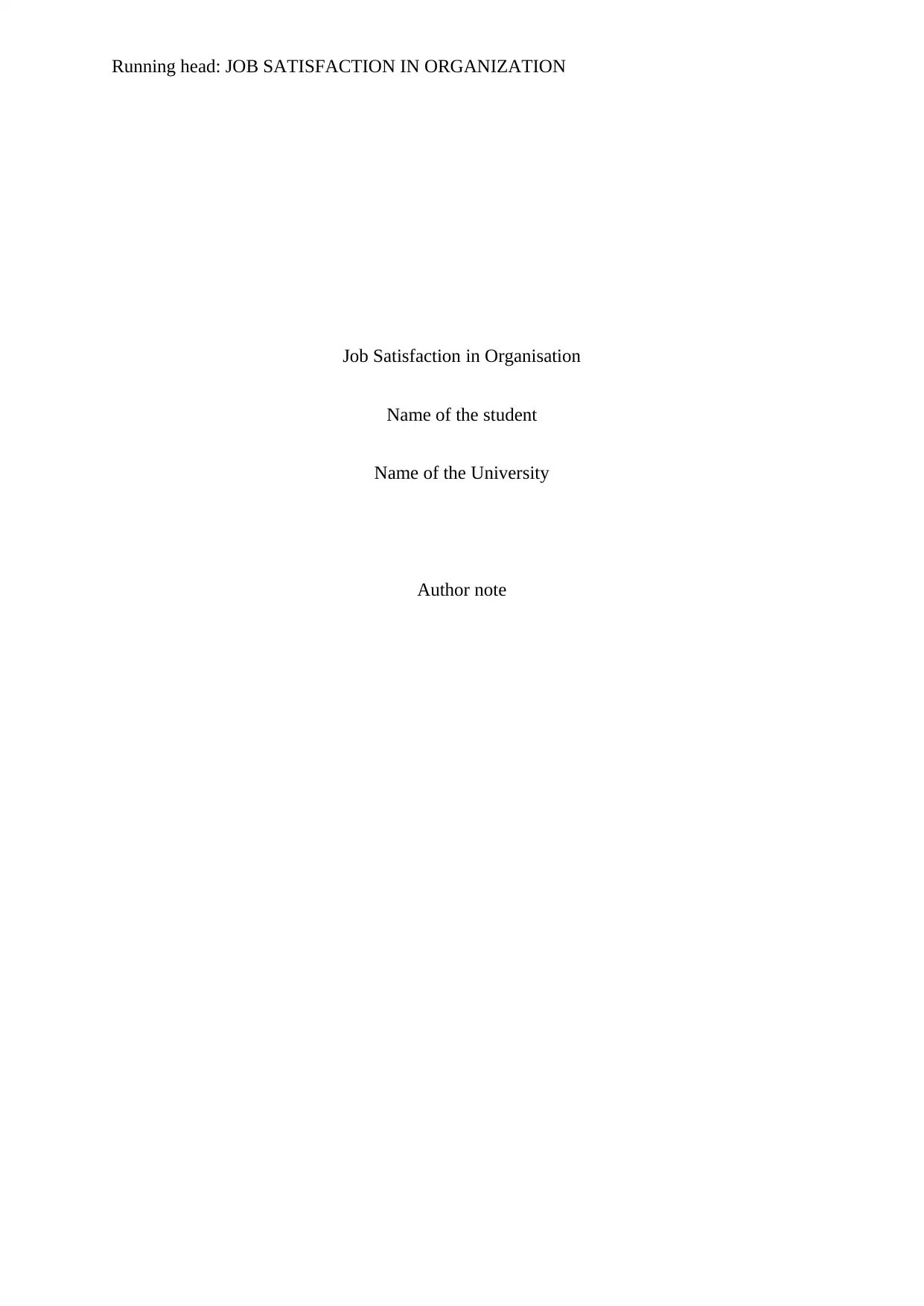
Running head: JOB SATISFACTION IN ORGANIZATION
Job Satisfaction in Organisation
Name of the student
Name of the University
Author note
Job Satisfaction in Organisation
Name of the student
Name of the University
Author note
Paraphrase This Document
Need a fresh take? Get an instant paraphrase of this document with our AI Paraphraser
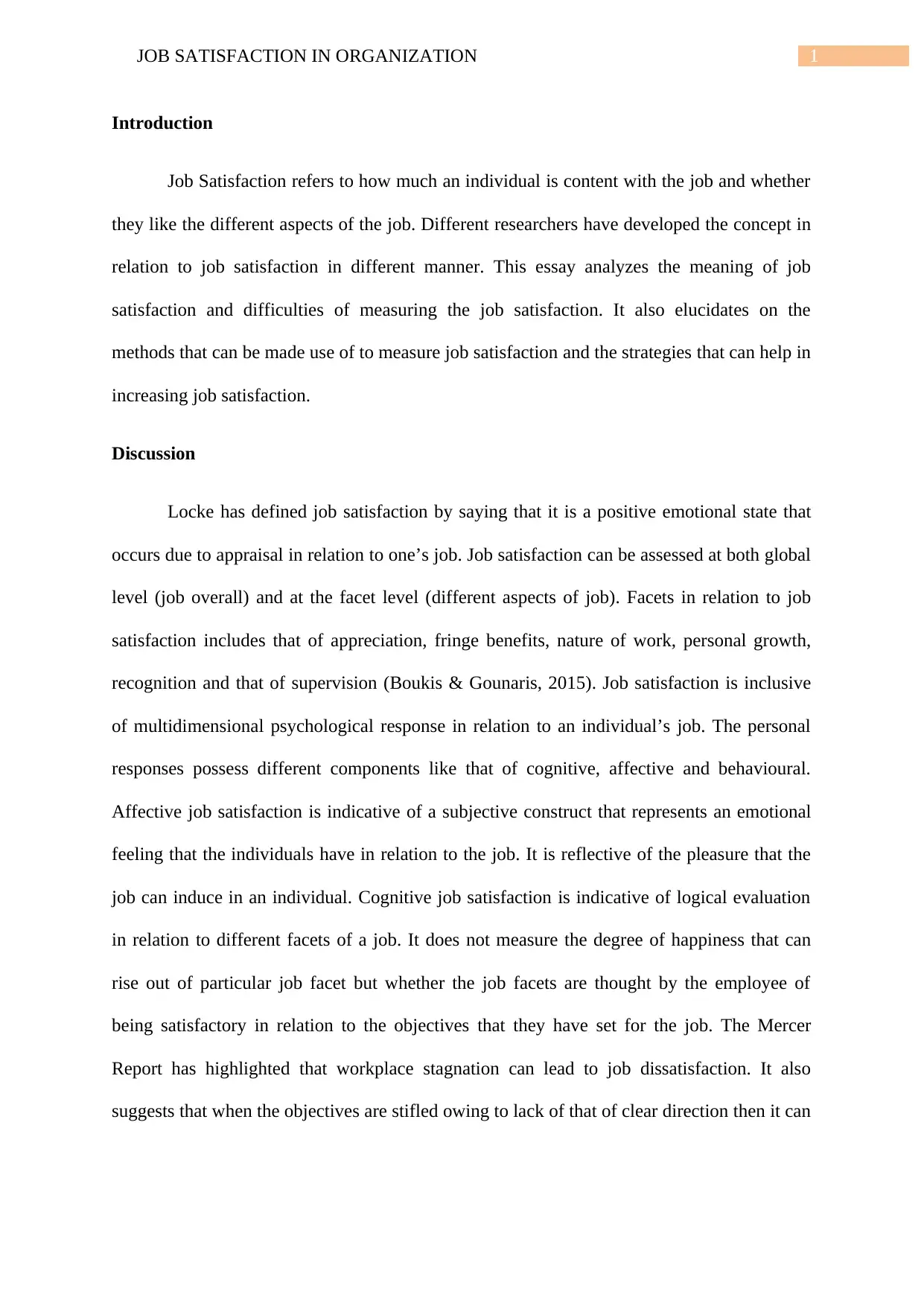
1JOB SATISFACTION IN ORGANIZATION
Introduction
Job Satisfaction refers to how much an individual is content with the job and whether
they like the different aspects of the job. Different researchers have developed the concept in
relation to job satisfaction in different manner. This essay analyzes the meaning of job
satisfaction and difficulties of measuring the job satisfaction. It also elucidates on the
methods that can be made use of to measure job satisfaction and the strategies that can help in
increasing job satisfaction.
Discussion
Locke has defined job satisfaction by saying that it is a positive emotional state that
occurs due to appraisal in relation to one’s job. Job satisfaction can be assessed at both global
level (job overall) and at the facet level (different aspects of job). Facets in relation to job
satisfaction includes that of appreciation, fringe benefits, nature of work, personal growth,
recognition and that of supervision (Boukis & Gounaris, 2015). Job satisfaction is inclusive
of multidimensional psychological response in relation to an individual’s job. The personal
responses possess different components like that of cognitive, affective and behavioural.
Affective job satisfaction is indicative of a subjective construct that represents an emotional
feeling that the individuals have in relation to the job. It is reflective of the pleasure that the
job can induce in an individual. Cognitive job satisfaction is indicative of logical evaluation
in relation to different facets of a job. It does not measure the degree of happiness that can
rise out of particular job facet but whether the job facets are thought by the employee of
being satisfactory in relation to the objectives that they have set for the job. The Mercer
Report has highlighted that workplace stagnation can lead to job dissatisfaction. It also
suggests that when the objectives are stifled owing to lack of that of clear direction then it can
Introduction
Job Satisfaction refers to how much an individual is content with the job and whether
they like the different aspects of the job. Different researchers have developed the concept in
relation to job satisfaction in different manner. This essay analyzes the meaning of job
satisfaction and difficulties of measuring the job satisfaction. It also elucidates on the
methods that can be made use of to measure job satisfaction and the strategies that can help in
increasing job satisfaction.
Discussion
Locke has defined job satisfaction by saying that it is a positive emotional state that
occurs due to appraisal in relation to one’s job. Job satisfaction can be assessed at both global
level (job overall) and at the facet level (different aspects of job). Facets in relation to job
satisfaction includes that of appreciation, fringe benefits, nature of work, personal growth,
recognition and that of supervision (Boukis & Gounaris, 2015). Job satisfaction is inclusive
of multidimensional psychological response in relation to an individual’s job. The personal
responses possess different components like that of cognitive, affective and behavioural.
Affective job satisfaction is indicative of a subjective construct that represents an emotional
feeling that the individuals have in relation to the job. It is reflective of the pleasure that the
job can induce in an individual. Cognitive job satisfaction is indicative of logical evaluation
in relation to different facets of a job. It does not measure the degree of happiness that can
rise out of particular job facet but whether the job facets are thought by the employee of
being satisfactory in relation to the objectives that they have set for the job. The Mercer
Report has highlighted that workplace stagnation can lead to job dissatisfaction. It also
suggests that when the objectives are stifled owing to lack of that of clear direction then it can
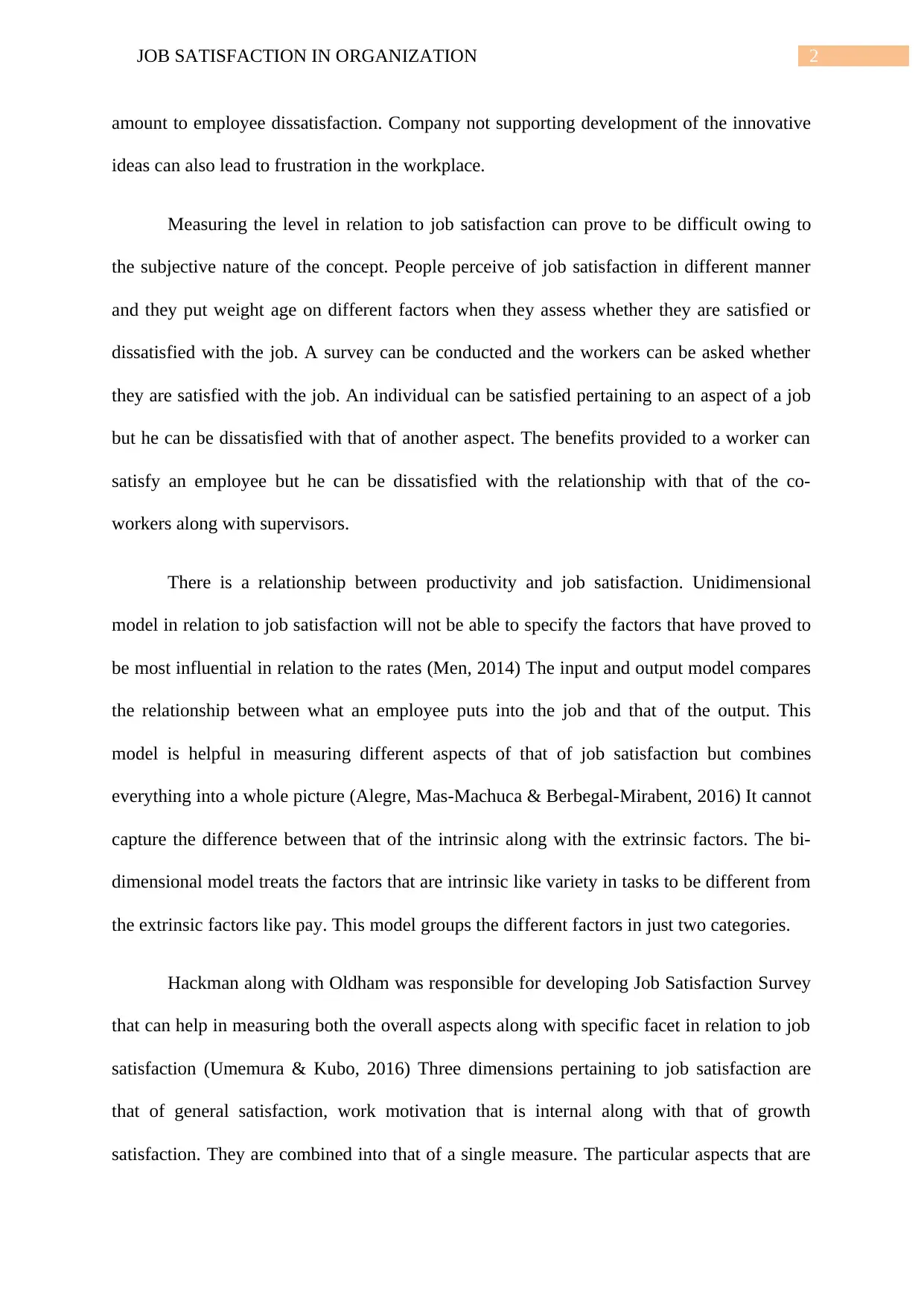
2JOB SATISFACTION IN ORGANIZATION
amount to employee dissatisfaction. Company not supporting development of the innovative
ideas can also lead to frustration in the workplace.
Measuring the level in relation to job satisfaction can prove to be difficult owing to
the subjective nature of the concept. People perceive of job satisfaction in different manner
and they put weight age on different factors when they assess whether they are satisfied or
dissatisfied with the job. A survey can be conducted and the workers can be asked whether
they are satisfied with the job. An individual can be satisfied pertaining to an aspect of a job
but he can be dissatisfied with that of another aspect. The benefits provided to a worker can
satisfy an employee but he can be dissatisfied with the relationship with that of the co-
workers along with supervisors.
There is a relationship between productivity and job satisfaction. Unidimensional
model in relation to job satisfaction will not be able to specify the factors that have proved to
be most influential in relation to the rates (Men, 2014) The input and output model compares
the relationship between what an employee puts into the job and that of the output. This
model is helpful in measuring different aspects of that of job satisfaction but combines
everything into a whole picture (Alegre, Mas-Machuca & Berbegal-Mirabent, 2016) It cannot
capture the difference between that of the intrinsic along with the extrinsic factors. The bi-
dimensional model treats the factors that are intrinsic like variety in tasks to be different from
the extrinsic factors like pay. This model groups the different factors in just two categories.
Hackman along with Oldham was responsible for developing Job Satisfaction Survey
that can help in measuring both the overall aspects along with specific facet in relation to job
satisfaction (Umemura & Kubo, 2016) Three dimensions pertaining to job satisfaction are
that of general satisfaction, work motivation that is internal along with that of growth
satisfaction. They are combined into that of a single measure. The particular aspects that are
amount to employee dissatisfaction. Company not supporting development of the innovative
ideas can also lead to frustration in the workplace.
Measuring the level in relation to job satisfaction can prove to be difficult owing to
the subjective nature of the concept. People perceive of job satisfaction in different manner
and they put weight age on different factors when they assess whether they are satisfied or
dissatisfied with the job. A survey can be conducted and the workers can be asked whether
they are satisfied with the job. An individual can be satisfied pertaining to an aspect of a job
but he can be dissatisfied with that of another aspect. The benefits provided to a worker can
satisfy an employee but he can be dissatisfied with the relationship with that of the co-
workers along with supervisors.
There is a relationship between productivity and job satisfaction. Unidimensional
model in relation to job satisfaction will not be able to specify the factors that have proved to
be most influential in relation to the rates (Men, 2014) The input and output model compares
the relationship between what an employee puts into the job and that of the output. This
model is helpful in measuring different aspects of that of job satisfaction but combines
everything into a whole picture (Alegre, Mas-Machuca & Berbegal-Mirabent, 2016) It cannot
capture the difference between that of the intrinsic along with the extrinsic factors. The bi-
dimensional model treats the factors that are intrinsic like variety in tasks to be different from
the extrinsic factors like pay. This model groups the different factors in just two categories.
Hackman along with Oldham was responsible for developing Job Satisfaction Survey
that can help in measuring both the overall aspects along with specific facet in relation to job
satisfaction (Umemura & Kubo, 2016) Three dimensions pertaining to job satisfaction are
that of general satisfaction, work motivation that is internal along with that of growth
satisfaction. They are combined into that of a single measure. The particular aspects that are
⊘ This is a preview!⊘
Do you want full access?
Subscribe today to unlock all pages.

Trusted by 1+ million students worldwide
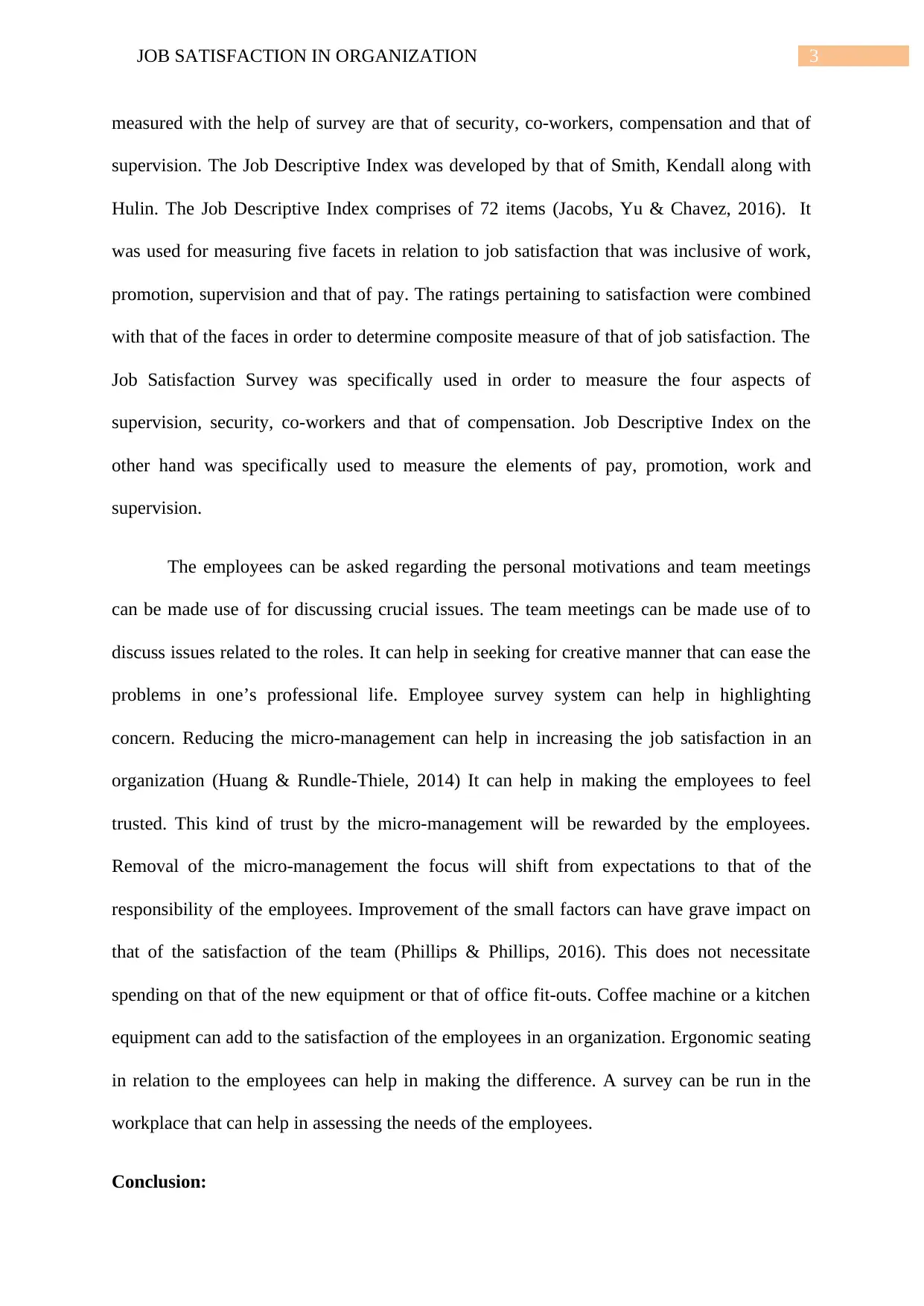
3JOB SATISFACTION IN ORGANIZATION
measured with the help of survey are that of security, co-workers, compensation and that of
supervision. The Job Descriptive Index was developed by that of Smith, Kendall along with
Hulin. The Job Descriptive Index comprises of 72 items (Jacobs, Yu & Chavez, 2016). It
was used for measuring five facets in relation to job satisfaction that was inclusive of work,
promotion, supervision and that of pay. The ratings pertaining to satisfaction were combined
with that of the faces in order to determine composite measure of that of job satisfaction. The
Job Satisfaction Survey was specifically used in order to measure the four aspects of
supervision, security, co-workers and that of compensation. Job Descriptive Index on the
other hand was specifically used to measure the elements of pay, promotion, work and
supervision.
The employees can be asked regarding the personal motivations and team meetings
can be made use of for discussing crucial issues. The team meetings can be made use of to
discuss issues related to the roles. It can help in seeking for creative manner that can ease the
problems in one’s professional life. Employee survey system can help in highlighting
concern. Reducing the micro-management can help in increasing the job satisfaction in an
organization (Huang & Rundle-Thiele, 2014) It can help in making the employees to feel
trusted. This kind of trust by the micro-management will be rewarded by the employees.
Removal of the micro-management the focus will shift from expectations to that of the
responsibility of the employees. Improvement of the small factors can have grave impact on
that of the satisfaction of the team (Phillips & Phillips, 2016). This does not necessitate
spending on that of the new equipment or that of office fit-outs. Coffee machine or a kitchen
equipment can add to the satisfaction of the employees in an organization. Ergonomic seating
in relation to the employees can help in making the difference. A survey can be run in the
workplace that can help in assessing the needs of the employees.
Conclusion:
measured with the help of survey are that of security, co-workers, compensation and that of
supervision. The Job Descriptive Index was developed by that of Smith, Kendall along with
Hulin. The Job Descriptive Index comprises of 72 items (Jacobs, Yu & Chavez, 2016). It
was used for measuring five facets in relation to job satisfaction that was inclusive of work,
promotion, supervision and that of pay. The ratings pertaining to satisfaction were combined
with that of the faces in order to determine composite measure of that of job satisfaction. The
Job Satisfaction Survey was specifically used in order to measure the four aspects of
supervision, security, co-workers and that of compensation. Job Descriptive Index on the
other hand was specifically used to measure the elements of pay, promotion, work and
supervision.
The employees can be asked regarding the personal motivations and team meetings
can be made use of for discussing crucial issues. The team meetings can be made use of to
discuss issues related to the roles. It can help in seeking for creative manner that can ease the
problems in one’s professional life. Employee survey system can help in highlighting
concern. Reducing the micro-management can help in increasing the job satisfaction in an
organization (Huang & Rundle-Thiele, 2014) It can help in making the employees to feel
trusted. This kind of trust by the micro-management will be rewarded by the employees.
Removal of the micro-management the focus will shift from expectations to that of the
responsibility of the employees. Improvement of the small factors can have grave impact on
that of the satisfaction of the team (Phillips & Phillips, 2016). This does not necessitate
spending on that of the new equipment or that of office fit-outs. Coffee machine or a kitchen
equipment can add to the satisfaction of the employees in an organization. Ergonomic seating
in relation to the employees can help in making the difference. A survey can be run in the
workplace that can help in assessing the needs of the employees.
Conclusion:
Paraphrase This Document
Need a fresh take? Get an instant paraphrase of this document with our AI Paraphraser
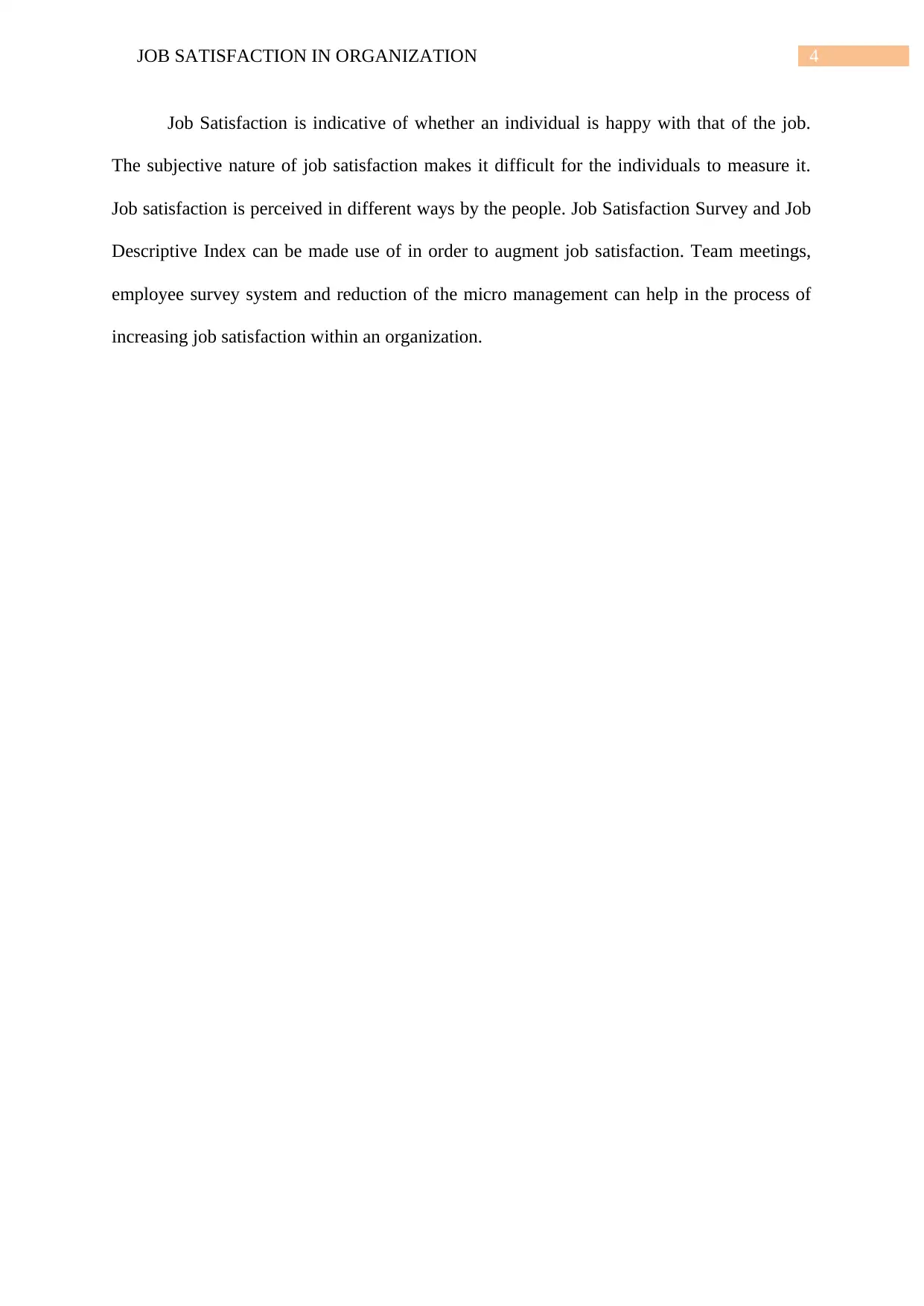
4JOB SATISFACTION IN ORGANIZATION
Job Satisfaction is indicative of whether an individual is happy with that of the job.
The subjective nature of job satisfaction makes it difficult for the individuals to measure it.
Job satisfaction is perceived in different ways by the people. Job Satisfaction Survey and Job
Descriptive Index can be made use of in order to augment job satisfaction. Team meetings,
employee survey system and reduction of the micro management can help in the process of
increasing job satisfaction within an organization.
Job Satisfaction is indicative of whether an individual is happy with that of the job.
The subjective nature of job satisfaction makes it difficult for the individuals to measure it.
Job satisfaction is perceived in different ways by the people. Job Satisfaction Survey and Job
Descriptive Index can be made use of in order to augment job satisfaction. Team meetings,
employee survey system and reduction of the micro management can help in the process of
increasing job satisfaction within an organization.
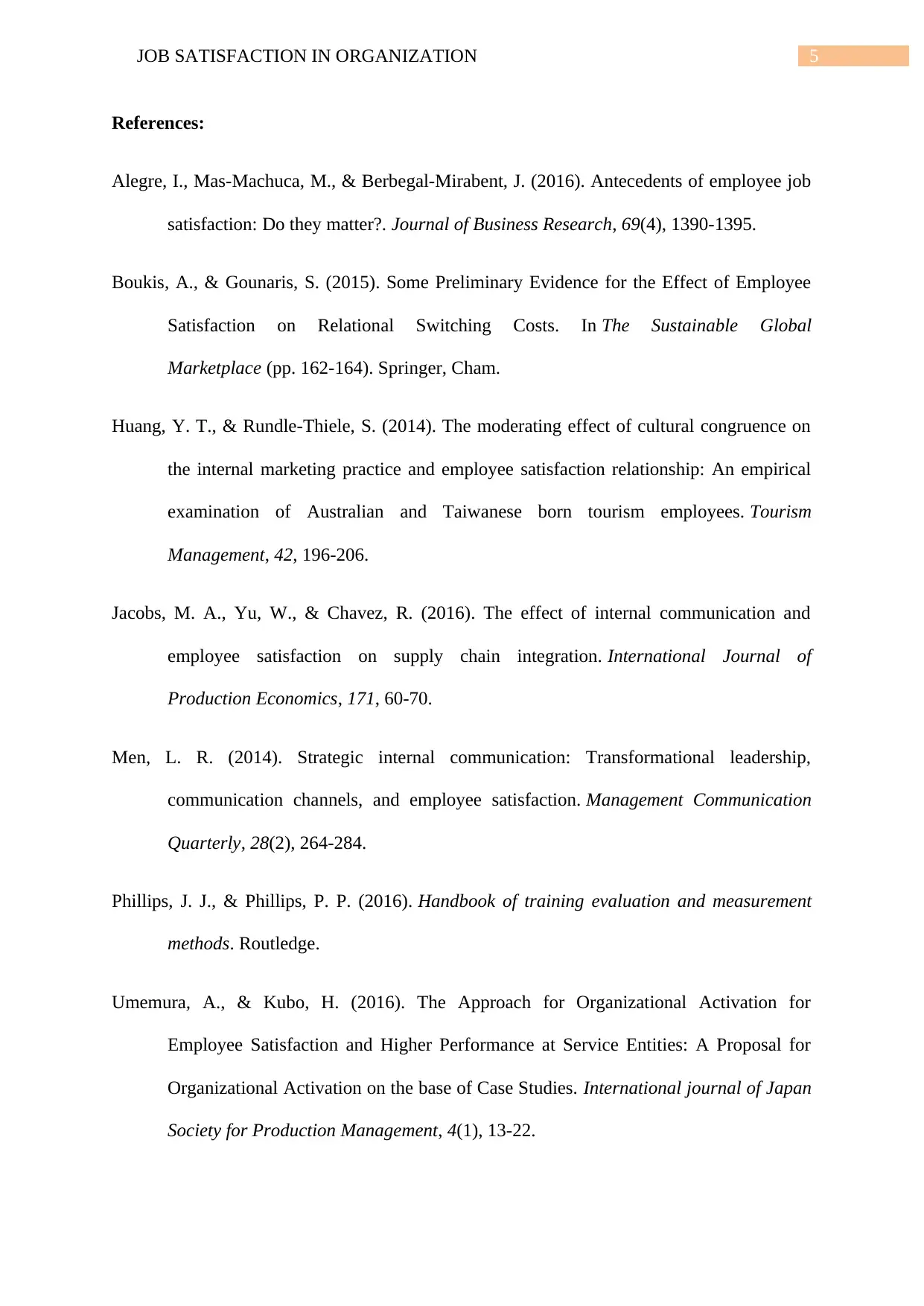
5JOB SATISFACTION IN ORGANIZATION
References:
Alegre, I., Mas-Machuca, M., & Berbegal-Mirabent, J. (2016). Antecedents of employee job
satisfaction: Do they matter?. Journal of Business Research, 69(4), 1390-1395.
Boukis, A., & Gounaris, S. (2015). Some Preliminary Evidence for the Effect of Employee
Satisfaction on Relational Switching Costs. In The Sustainable Global
Marketplace (pp. 162-164). Springer, Cham.
Huang, Y. T., & Rundle-Thiele, S. (2014). The moderating effect of cultural congruence on
the internal marketing practice and employee satisfaction relationship: An empirical
examination of Australian and Taiwanese born tourism employees. Tourism
Management, 42, 196-206.
Jacobs, M. A., Yu, W., & Chavez, R. (2016). The effect of internal communication and
employee satisfaction on supply chain integration. International Journal of
Production Economics, 171, 60-70.
Men, L. R. (2014). Strategic internal communication: Transformational leadership,
communication channels, and employee satisfaction. Management Communication
Quarterly, 28(2), 264-284.
Phillips, J. J., & Phillips, P. P. (2016). Handbook of training evaluation and measurement
methods. Routledge.
Umemura, A., & Kubo, H. (2016). The Approach for Organizational Activation for
Employee Satisfaction and Higher Performance at Service Entities: A Proposal for
Organizational Activation on the base of Case Studies. International journal of Japan
Society for Production Management, 4(1), 13-22.
References:
Alegre, I., Mas-Machuca, M., & Berbegal-Mirabent, J. (2016). Antecedents of employee job
satisfaction: Do they matter?. Journal of Business Research, 69(4), 1390-1395.
Boukis, A., & Gounaris, S. (2015). Some Preliminary Evidence for the Effect of Employee
Satisfaction on Relational Switching Costs. In The Sustainable Global
Marketplace (pp. 162-164). Springer, Cham.
Huang, Y. T., & Rundle-Thiele, S. (2014). The moderating effect of cultural congruence on
the internal marketing practice and employee satisfaction relationship: An empirical
examination of Australian and Taiwanese born tourism employees. Tourism
Management, 42, 196-206.
Jacobs, M. A., Yu, W., & Chavez, R. (2016). The effect of internal communication and
employee satisfaction on supply chain integration. International Journal of
Production Economics, 171, 60-70.
Men, L. R. (2014). Strategic internal communication: Transformational leadership,
communication channels, and employee satisfaction. Management Communication
Quarterly, 28(2), 264-284.
Phillips, J. J., & Phillips, P. P. (2016). Handbook of training evaluation and measurement
methods. Routledge.
Umemura, A., & Kubo, H. (2016). The Approach for Organizational Activation for
Employee Satisfaction and Higher Performance at Service Entities: A Proposal for
Organizational Activation on the base of Case Studies. International journal of Japan
Society for Production Management, 4(1), 13-22.
⊘ This is a preview!⊘
Do you want full access?
Subscribe today to unlock all pages.

Trusted by 1+ million students worldwide
1 out of 6
Related Documents
Your All-in-One AI-Powered Toolkit for Academic Success.
+13062052269
info@desklib.com
Available 24*7 on WhatsApp / Email
![[object Object]](/_next/static/media/star-bottom.7253800d.svg)
Unlock your academic potential
Copyright © 2020–2025 A2Z Services. All Rights Reserved. Developed and managed by ZUCOL.





